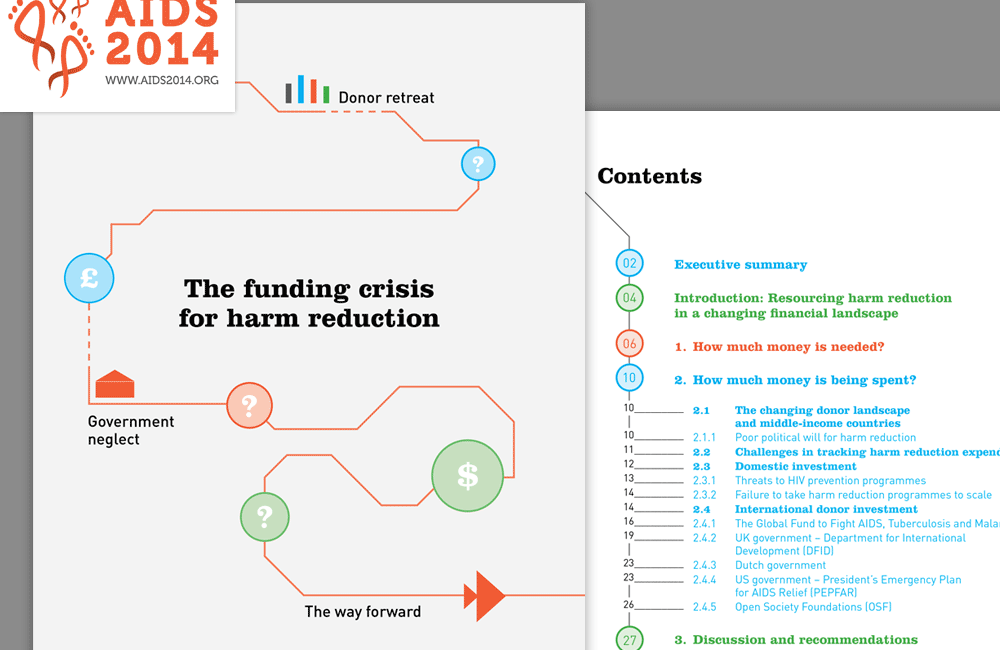
International donors are investing only 7% of what is needed to provide adequate harm reduction coverage for people who inject drugs, according to findings from a report presented on Wednesday at the 20th International AIDS Conference (AIDS 2014) in Melbourne.
A global commitment to rebalance spending on drug control and harm reduction is essential in order to achieve control of HIV and hepatitis among people who inject drugs, several speakers told the conference.
Global Drug Commissioner, Sir Richard Branson, who joined the conference by video link, said the global war on drugs had failed both in terms of controlling drug trafficking and consumption and of public health outcomes, particularly in relation to HIV and hepatitis C.
He said that the time has come to replace the criminalisation and punishment of drug users with treatment and health care.
“Drug policy reform should not be seen in isolation” Sir Richard Branson said. “It has the potential to affect change in other areas such as the world’s chronically overcrowded penal system or of reducing the negative impact of policing on some communities.
“Globally, we’re using too much money and far too many precious resources on incarceration when we should be spending this money on education, vocational training, and in the case of drug users, on treatment, proper medical care and re-entry.”
The survey of harm reduction funding, carried out by Harm Reduction International, the International Drug Policy Consortium and the International HIV/AIDS Alliance, found that donor governments and the Global Fund to Fight AIDS, Tuberculosis and Malaria invested US$160 million in harm reduction programming in 2010, with little sign of subsequent growth. UNAIDS estimates that it would cost $2.3 billion a year to provide adequate coverage of harm reduction measures.
The core harm reduction measures include not only needle and syringe programmes, opioid substitution therapy, and targeted education and outreach, but also HIV testing and counselling, antiretroviral therapy, condom programming and prevention, diagnosis and treatment of sexually transmitted infections, viral hepatitis and tuberculosis.
Presenting the findings, Susie McLean of the International HIV/AIDS Alliance told conference delegates that existing coverage is extremely low. On average, just two clean needles and syringes were distributed to each person who injects drugs each month in 2010, and only 8% of people who inject drugs had access to opioid substitution therapy. In 71 countries, needle and syringe programmes are not available despite reported injecting drug use and 81 countries with reported injecting drug use do not provide opioid substitution therapy.
Since these estimates of coverage were developed in 2010, there has been little progress on the expansion of harm reduction, and the survey found some evidence of a retreat by donors from funding harm reduction, as part of a wider move away from funding health and development activities in middle-income countries. This is despite the fact that among the 15 countries considered the highest priority for tackling HIV in people who inject drugs, 84% of people who inject drugs reside in upper middle-income countries such as China, Russia, Kazakhstan, Iran and Thailand.
Several major donors have taken actions that are cutting off access to harm reduction funding in practice, even though donors endorse harm reduction expenditure as a good investment in HIV prevention. The Global Fund to Fight AIDS, Tuberculosis and Malaria recommends investment in evidence-based harm reduction measures, but its new funding model has shifted resources away from middle-income countries with the highest need for harm reduction programming. Thailand allocated just 1% of its total HIV prevention budget to harm reduction in 2010, highlighting the need for donor investment. A similar pattern is evident across almost all Asian countries with a high burden of HIV among people who inject drugs. Of the 58 countries previously eligible for harm reduction funding, 24 are now ineligible for further support.
The United Kingdom government is also retreating from harm reduction funding and will give no direct support to harm reduction programming after 2016.
Despite a legislative ban on funding for needle and syringe programmes, the US PEPFAR programme spent approximately US$27.7 million on harm reduction in 2011. However, this represented only 2% of PEPFAR funding in the countries where support was provided; in Vietnam for example, harm reduction programming represented only 11% of expenditure despite the predominance of injecting drug use as a mode of HIV transmission in Vietnam’s epidemic.
Susie McLean said that in order to fund harm reduction adequately, the Global Fund needs to remain a truly global fund. Its funding model should be reframed to take into account national policy barriers to implementation of evidence-based measures, as well as political will to pay for harm reduction. Similarly, international donors should continue to invest where national governments won’t, using their influence to steer national funding policies towards a more equitable distribution of HIV prevention funding. National governments need to tackle the stigma associated with drug use in order to allow a more rational debate about harm reduction spending.
Most importantly, the international community needs to ask hard questions about the cost effectiveness of drug control policies. Drug enforcement spending on prisons, policing, courts and probation has been estimated to cost around US$100 billion. Even if this represents a substantial over-estimate, there is a grave mismatch between drug control spending and harm reduction spending, despite the fact that each form of spending is argued to achieve the same end – minimising the harm caused by drug use.
McLean called for international donors to set a global target for harm reduction funding, reminding the audience that ahead of the UNGASS 2016 summit on drugs, advocates are calling for harm reduction funding to be scaled up to reach one-tenth of the amount spent on drug control.
Cook S, Bridge J, McLean S Is harm reduction funding in low and middle income countries in crisis? 20th International AIDS Conference, Melbourne, abstract WeAE0201, 2014.
View the abstract on the conference website.
The funding crisis for harm reduction – download the full report.
